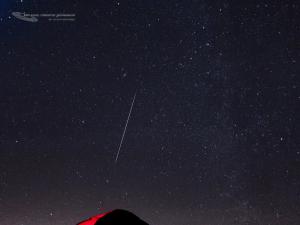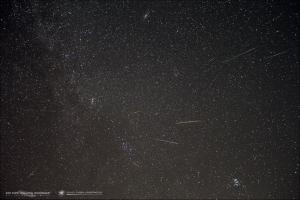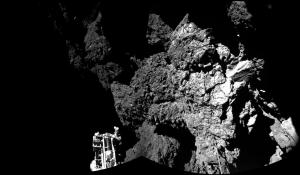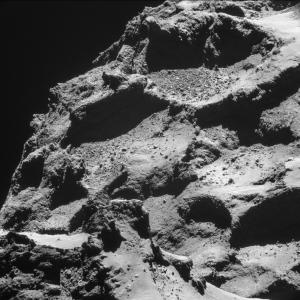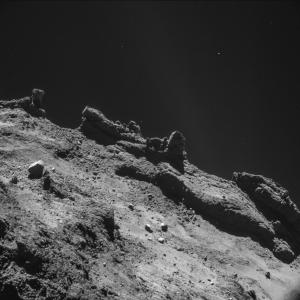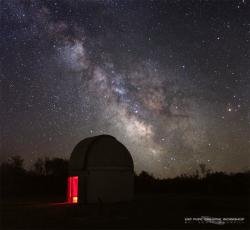
Public Stargazing
- Where:
- Frosty Drew Observatory
- When:
- Friday November 14, 2014 at 6:30 p.m.
- Cost:
- $1 Suggested Donation per Person
Tonight's forecast is calling for clear skies, light wind, and cold temps dropping into the low 30's. Clear skies will be favorable to our observation tonight as the third quarter Moon will not rise until 11:44 p.m. offering us super dark skies to revel in an impressive list of nebulae, star clusters, and galaxies. We plan to open the Observatory and Sky Theatre at 6:30 p.m. In the Sky Theatre we will have a relaxing slideshow on display showcasing the fascinating celestial objects we see at Frosty Drew. The Observatory will feature many deep sky objects including The Ring Nebula, The Dumbbell Nebula, The Hercules Cluster, and much more. An hour before moonrise, Jupiter will appear on the Eastern horizon and become visible to our telescopes around 11:30 p.m. Temps could drop below freezing later in the night so come prepared. Winter coat, warm shoes, and hats will certainly be a necessity.
Tonight looks to be an excellent night to be under the stars at Frosty Dew. Make tonight your night to become affiliated with the fantastic starscape of Charlestown, Rhode Island.
-------------------------------------------------------------------------
Weekly Happenings
Scott MacNeill
Next week, coming to a dark sky over planet Earth, the annual Leonid meteor shower is poised to dazzle sky watchers with a streaking display of up-to 15 meteors per hour. Add that only a thin waning crescent Moon will be up during the early morning hours, viewing of the 2014 Leonids should be excellent if weather can keep the skies clear.
Leonid meteors are the result of Earth passing through the debris field of Comet 55P/Tempel-Tuttle (Comet 55P), a periodic comet that orbits the Sun once every 33 years. Comet 55P is a rather small comet with a nucleus measuring only 2.24 miles in diameter. The 33 year orbital period makes for a fantastic shower of storm conditions happening on a 33 year interval. The last Leonid meteor storm happened in 2002 and floored meteor watchers with hundreds of meteors lighting up the skies.
Viewing the 2014 Leonid meteor shower is best during the early morning hours, just after midnight on Monday and Tuesday morning. Set out to a dark location, bring a reclining lawn chair and blankets, and lie on your back with your feet facing the East so you are looking towards the sky in a relaxed position. Meteors will appear to radiate from the constellation Leo (The Lion). Leonid meteors are known for the extremely fast rate that they streak across the sky. The Leonid shower also has a reputation of producing a fair share of fireball meteors, which are meteors that are extremely bright and long lasting.
So gear up on the morning of Monday and Tuesday (November 17-18), dress warm, kick back with coffee and hot chocolate and celebrate a night out under beautiful skies with a rising crescent Moon and the occasional shooting star.
This past Wednesday morning, history was made yet again when the European Space Agency (ESA) Rosetta mission landed the Philae lander on Comet 67P/Churyumov–Gerasimenko (Comet 67P). Though this is a massive moment for space exploration, the historic landing did not happen glitch free.
Philae detached, as expected, from the Rosetta spacecraft on schedule at 3:35 a.m. EST on Wednesday November 12th. The descent to the primary landing site, named Agilkia, on the surface of Comet 67P was expected to take 7 hours, after which Philae would gently touch down on the comet's surface, fire anchoring harpoons, and drill into the surface to secure its attachment. Well that is not exactly what happened. Approximately 7 hours after detachment, Philae reached the surface of Comet 67P and touched down at speeds of 2.25mph. Though the anchoring harpoons never fired causing Philae to bounce back into space. Due to the extremely low gravity of Comet 67P, the bounce propelled Philae 0.6 miles back into space for another 110 minutes! Once finally reaching the surface of the comet, again, and now 0.6 miles away from the Agilkia site, Philae touched down and experienced another bounce. This second bounce propelled Philae back into space for 7 more minutes before finally touching down on the edge of the comet.
At present, Philae is on the comet's surface and relatively unharmed from the three landing procedures. The bad news is the Philae lander is not at any of the intended landing sites. One of the core requirements when selecting landing sites was the availability of enough sunlight to allow for recharging of Philae's batteries. Well the Agilkia site would have offered 7 hours of sunlight, compared to the current location only offering about 1.5 hours worth of solar exposure. The primary battery that Philae has been operating on will not last another day. This new location and resulting lack of sunlight will significantly degrade the possibility of coveted surface comet observations planned to take place over the next several months.
Overall, the Rosetta mission is amazing! The accomplishments to date made by this lonely spacecraft over 300 million miles away are mind blowing. Humans have caught up with, acquired orbit, and soft-landed on a comet! And, we did it with a spacecraft that has been residing in space for a decade. The Rosetta orbiter is still functioning fine and will continue its mission as planned. As for Philae, only time will tell. So in the spirit of the awesome things this little spacecraft is doing, let's all project hopeful thoughts to the sky and keep positive attitudes as Philae has had a monumentally tough week! Keep up with the ESA Rosetta mission and check out some of the beautiful photos Rosetta has been snapping of Comet 67P.
-Scott

